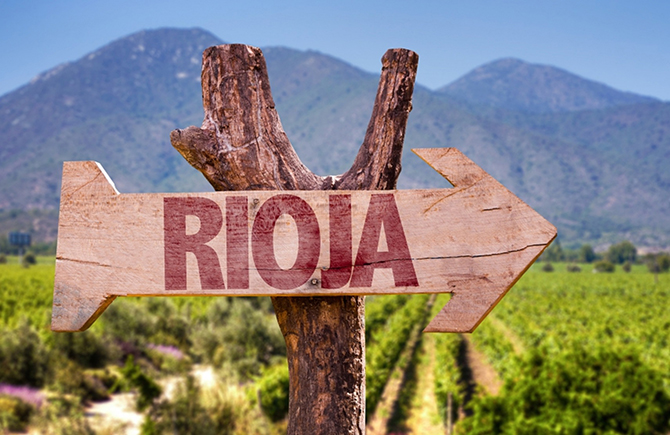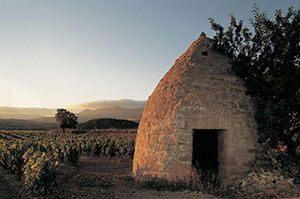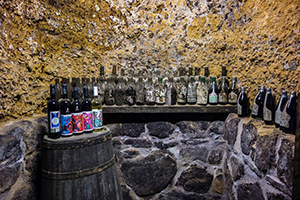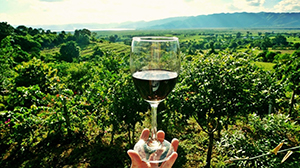RIOJA Spain’s Soulful Wine Paradise

By Gretchen Kelly
There is a phrase in Spanish that is so full of meaning that it’s almost untranslatable. The phrase is duende: a word that means dark, meaningful, redolent of soul and significance. Although the word has come to signify the Southern Spanish culture of Flamenco, I found duende in the deep red wines of Spain’s wine growing region of Rioja where the earth is almost as blood red as the red varietal that grows here in abundance: the Tempranillo grape.
This rough, stony red earth is found in all the three principal wine growing regions of La Rioja: Rioja Alavesa, Rioja Alta, and Rioja Baha. All are part of a protected designation of origin and all are as varied and ripe with flavor as the wines.
After arriving in Madrid with some fellow wine lovers (including one wine expert who both looked and talked like Sideways’ film wine hero, Paul Giamatti), we took a short hop to the region by connecting to a flight to Bilbao, followed by an hour’s drive to the region’s capital of Haro. Although it is the capital of the region, Haro is smaller and more easily walkable than Rioja’s other major city, Logroño, an old historic town with its intimate city center.

BODEGA MUGAS WINERY
Our first stop and our introduction to Rioja wine tasting was the Bodega Mugas Winery (bodegasmuga.com) one of the oldest and most esteemed wineries in the region. The Mugas family has lived in Haro for over 300 years but created the winery in 1932, moving it to an iconic 19th century complex of buildings just outside of town near a railway station. The complex is punctuated by a scalable bell tower from which you can see gold and green vineyards far into the horizon.
In the winery complex itself, you may get a chance to taste Mugas wines with one of the family members who oversee every aspect of the business. You can also watch oak casks being toasted (and inhale that wonderful aroma) as Mugas is one of the only wineries in Rioja to make and repair its casks from French oak. Try to taste the vineyard’s iconic Prado Enea a deep, spiced wine that gets its gravitas from a late harvest of selected grapes plus aging in 16,000-liter oak vats for 12 months, followed by 36 months in both oak casks and bottles.

VIVACO MUSEUM OF WINE CULTURE
After a night spent having dinner with Mugas wines in Haro’s Hotel Los Agustinos (hotellosagustinos.com), a converted convent with a welcoming cloister square we moved on to the Vivaco Museum of Wine Culture (vivancoculturadevino.es/en/foundation/vivanco-museum-of-wine-culture/) the next day. The Museum is housed in a vast complex and adjacent vineyards with a well and where the current owner, Raphael Vivaco can be seen in a video lovingly extolling the region, its history, and its grapes. The complex is not as intimate as many of the wineries in the area but the museum is a worthwhile stop, and you can also walk the rows of grapes outside the museum complex, getting a feel for the rich earth that yields the Tempranillo grapes their rounded, full-bodied taste. Be sure to stop by the The Vivaco Restaurant with full-picture windows overlooking the vineyard. The menu is influenced by the region’s traditional love of pork: deeply fatted and flavorful and a perfect partner for Tempranillo.
EZCARAY
Moving through the region to the town of Ezcaray on the banks of the River Oja, we checked into the Hotel Relais Chateau Echaurren a small gem of a hotel with views of the local Santa María la Mayor Church. It was a dubious delight I came to discover, as the church bells seemed to peal on the half as well as the full hour right outside the French doors of my room. Dinner at the Hotel’s two-Michelin-starred El Portal Echaurren, helmed by local chef Francis Paniego was a slowly evolving revelation of sensual delights paired elegantly with perfectly balanced regional wines and even local structural elements like vine wood used as dishes.

DAVID MORENO WINERY
The next day we spent hours in the David Moreno Winery (davidmoreno.es/en/) in Badarán, first in a stone hut tasting room in the midst of the vineyard. Then we moved to the Moreno wine complex where we learned to stomp on grape vines in vats just like Lucille Ball did all those years ago in that iconic winemaking episode. This winery was built in 1981 when then engineer, Moreno, came back to his family town with a dream to develop a winery. The dapper gentleman in his signature Basque cap is still very much in evidence on a visit to the winery, where you’ll also find his grown children hosting tastings and tours. A short drive from the Moreno winery are the UNESCO protected sites of the Monasteries of Suso and Yuso: ancient sites with graves that date to the time of El Cid and with mountainside views of the local rocky landscape.
The next day, we got a a bird’s-eye view of that landscape with an early morning balloon ride over Haro’s vineyards the next day, topped off with a Prosecco toast once the balloon had reached a high enough altitude that we actually saw the ghost of our balloon’s reflection in the clouds.
Back on the ground, our wine tour ended in the lively town of Logroño where we reveled in tapas into the wee hours of the morning in the Calle Laurel, a street lined with so many tapas restaurants you feel that the night will never end. A reminder that in Spain, there is no curfew on the pleasure of wine, food and, of course, good company.





